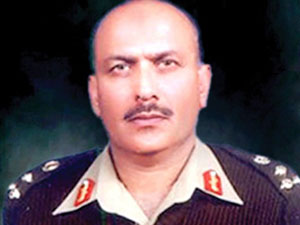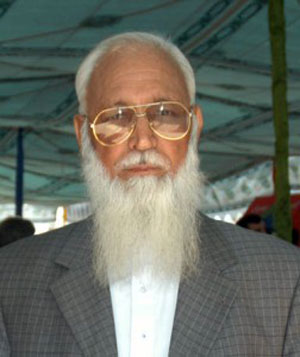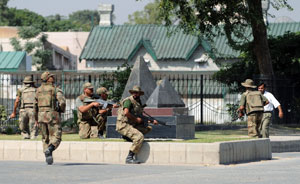Cover Story: Jihadis in the Ranks
By Imtiaz Gul | News & Politics | Published 13 years ago
The conclusion of a preliminary investigation report on the Kamra Base attack, released to the media on August 25, ruled out ‘insider’ support to the militants behind the August 16 attack on the Pakistan Air Force (PAF) airbase. The weapons used in the attack — AK-47 rifles, five hand-grenades and three rocket-propelled grenades (RPGs) — were all of Russian-origin. This conclusion typifies the typical state of denial that has been the hallmark of most Pakistanis, as well as elements within the security establishment, who are simply overlooking the religious radicalisation that is taking place across the ranks of the armed forces. Not only have ideologically-driven officers attempted to overthrow their own ‘infidel leadership,’ but several instances seem to suggest that such over-zealous officers also provided crucial direct or indirect support to those anti-western militant networks they consider as being vital for the defence of the Islamic Republic of Pakistan. The ‘insider’ connection was, indeed, common to all major attacks on the GHQ, Rawalpindi (October 10, 2009), the PNS Mehran Naval Base, Karachi (May 22, 2011) and the Minhas Airbase, Kamra (August 16, 2012), as well as the attack on General Pervez Musharraf in December 2003. Beyond a shadow of doubt, this nexus betrays a creeping malaise within the armed forces, where a lot of the rank and file appear attracted to the explosive Al Qaeda-inspired anti-western narrative, resulting in direct or indirect complicity in attacks on, within and from outside, the garrison.
The Radicals Within
In his story on the PNS Mehran attack, Saleem Shehzad, the slain Asia Times Online correspondent pointed to the ‘insider’ connections of the attackers to certain navy officers/personnel.

‘Rogue’ officer: Following a court martial, Brig Ali Khan and four other officers were sentenced to imprisonment on August 3, 2012
The leader of the attack on the General Headquarters (GHQ), Muhammad Aqeel alias Dr Usman, sentenced to death in August 2011, for instance, was one of several former military personnel to have joined terrorist groups. He had served in the medical corps before abandoning his job and joining terrorists based in North Waziristan.
In early August this year, military authorities announced that a military court had sentenced Brigadier Ali Khan and four majors to varying imprisonment terms for their membership of a pan-Islamist organisation, Hizb ut-Tahrir (HuT), and for attempting to overthrow the political order in the name of religion.
These are not isolated incidents involving ‘rogue’ officers. In fact they offer only glimpses of an ever-growing list of suspensions, convictions and internments of military officials and lower rank personnel, who are either dissatisfied with the GHQ or oppose government and military leadership on ideological grounds, or are doing so out of direct sympathy for pan-Islamist groups and are desirous of installing a Khilafa or Shariah style-governance in Pakistan.
In the mid-1990s, the Military Intelligence (MI) busted a group of officers, led by Major General Zaheerul Islam Abbasi and Brigadier Mustansir Billah, as they were planning to stage a coup against then prime minister, Benazir Bhutto.

Brig Zaheerul Islam Abbasi, one of the masterminds of ‘Operation Khalifa,’ the coup to overthrow Benazir Bhutto
The 1995 ‘Operation Khilafa’ aimed at taking over the GHQ at the time of a Corps Commanders’ Conference, by eliminating key commanders, and then taking over the country with the ultimate objective of imposing a Taliban-style Sunni government. Several years ago, Captain Farooq, one of General Pervez Musharraf’s security officers, had also been detected as a member of the Hizb ut-Tahrir. The MI had discovered Farooq’s association with the HuT almost nine months after his posting as the security officer to the president. Once spotted, he was briefly arrested and then retired from the army.
In 2009, a squadron leader, Nadeem Ahmed Shah lost his post after the MI figured out his links with the outlawed HuT. Shah, originally a civilian employee of the Air Weapons Complex (AWC) near Islamabad, was then the commanding officer at the Shamsi Airbase in Balochistan, a facility that had practically been handed over to the US-NATO forces after the war on terrorism unfolded on October 7, 2001.
Muhammad Altaf, a civilian employee of the National Development Complex (NDC) that comes under NESCOM and deals with ballistic missile development, too, was arrested for his alleged links with a banned outfit.

Brig Mustansir Billah was the other mastermind of ‘Operation Khalifa.’
In January 2005, a military court sentenced three air force officers to terms ranging from two to nine years for their alleged links with the Jaish-e-Mohammad, led by Maulana Masood Azhar. Mobile phone intercepts helped trace conversations with these officers, which led to their termination and imprisonment. They had been part of a gang within the military which was passing on information to Jaish-e-Mohammad before the two attacks on General Pervez Musharraf in 2003.
Five of the 57 soldiers arrested in connection with the two assassination attempts on General Musharraf received the death sentence (reported in June 2009). Most of them were corporals and junior technicians. They also included two soldiers of the Special Services Group (SSG). The explosives used in the first attempt on December 15, 2003 had been stolen from a Pakistan Air Force (PAF) depot by one of the convicted airmen. Though some of the airmen were given in-house sermons on radicalisation, others took a one-year leave on the pretext of accompanying the preaching groups, but when they were later arrested, it transpired that they had in fact been training with different militant groups. In May 2005, a court handed down the death sentence [in absentia] to another accused in the conspiracy to assassinate Pervez Musharraf — Naik Arshad Mahmood of the SSG. Others named in the case included Havaldar Mohammad Younis of the 98 Air Defence Regiment, who was sentenced to 10 years hard labour, and Lance Naik Zafar Iqbal Dogar of the SSG, who abandoned the mission halfway and turned a state witness.
In September the same year, another military court sentenced Major Adil Qudoos, Colonel Abdul Ghaffar, and Colonel Khalid Abbasi to different terms on charges of indulging in activities that conflicted with their duties. One of the charges they faced was facilitating Al Qaeda-linked fighters. They had also put up associates of Khalid Sheikh Mohammad, the alleged 9/11 mastermind arrested from Rawalpindi in 2003, at the army’s hostels.
In one instance, a soldier, Abdul Islam Siddiqui, was executed in August 2005 following a closed-door Field General Court Martial (FGCM) for complicity in an attack on General Musharraf. The 35-year-old Siddiqui, the court established, pressed the button of the remote control device which caused an explosion targeting Musharraf in Rawalpindi on December 14, 2003.
His execution was a clear warning to Islamists in uniform of dire consequences if they deviated from their duty, or threatened the interests of the institution. The charges against Islam Siddiqui included abetting a mutiny against the army chief and attempting to persuade ‘a person in the military’ to rebel against the government. He was also charged with receiving training in Bhimber (Jammu & Kashmir) at a Jaish-e-Mohammad-run training camp. But Islam Siddiqui’s family members insist that he was actually arrested in South Waziristan, after he had refused to fight against local tribes suspected of having links with the Taliban and Al Qaeda.
 The assassination of the ex-GOC of SSG, Maj Gen Ameer Faisal Alavi, was plotted by a retired major, Haroon Ashiq. After joining the Lashkar-e-Taiba, he moved on to work with Ilyas Kashmiri of the Brigade 313 linked with Al Qaeda. Ashiq’s brother, Captain Khurram, had retired from the army only to join the Taliban and other fighters in Afghanistan. He was killed in 2007 in Afghanistan’s Helmand province. Various other retired soldiers, many of whom had liaised with the Taliban during the ’90s, returned to Afghanistan to fight on a voluntary basis too.
The assassination of the ex-GOC of SSG, Maj Gen Ameer Faisal Alavi, was plotted by a retired major, Haroon Ashiq. After joining the Lashkar-e-Taiba, he moved on to work with Ilyas Kashmiri of the Brigade 313 linked with Al Qaeda. Ashiq’s brother, Captain Khurram, had retired from the army only to join the Taliban and other fighters in Afghanistan. He was killed in 2007 in Afghanistan’s Helmand province. Various other retired soldiers, many of whom had liaised with the Taliban during the ’90s, returned to Afghanistan to fight on a voluntary basis too.
However, Maj Haroon Ashiq is not the only officer with links to the Al Qaeda. In 2003, Major Adil Qudoos of 45 Signals too was arrested and later sentenced for being linked to the militant network.
It is not only people in higher positions in the army who are the main cause of concern, radicalisation in the lower ranks is equally disturbing. The deadly Jundallah group, an offshoot of the rabidly anti-Shia Lashkar-e-Jhangvi, which carried out the assassination attempt on the then Karachi Corps Commander, Gen Ahsan Saleem Hayat in 2004, comprised serving and ex-soldiers of the army and the air force. Jundallah has become notorious as a small but deadly force.
A Bitter Reality
Senior army officials use convictions and preemptive arrests such as those of Brig Khan, to underscore the effective monitoring mechanisms within the armed forces, and believe that the multi-layered mechanism makes it almost impossible for a few officers to take over. But the bitter reality staring them in the face is that while intelligence could sniff out some of the coup plots or locate ideologically-driven dissenting people, they failed in preventing major attacks on key military installations involving insiders.
They serve as a source of worry, because they are indicative of the Al Qaeda’s assertion of power and the vulnerability of the security establishment, even at as high places such as the Rawalpindi GHQ or the Minhas Airbase at Kamra. They end up demoralising the rank and file of the armed forces.
Pakistan is drifting into a strategic black hole. Does the country really think that the best way forward is as an adversary of the United States, currying favour with militants, and becoming a vassal of China? Are its role models North Korea and Burma? Or does it want to crush the jihadist movements that are destroying the country, join the global economy, reform its society, and become a real democracy? These are the questions that Pakistan needs to ask itself.
Brig Khan’s arrest and eventual conviction may have been surprising to many, but most Pakistanis are unaware that the army, particularly after five high-profile attacks including two on former president Pervez Musharraf in December 2003, instituted mechanisms to keep an eye on suspect militant-minded officers. The detention of dozens of commissioned and non-commissioned officers of the army and the air force in connection with the suicide attacks targeting Musharraf’s cavalcade in Rawalpindi did surprise the military high command, confronting it with a new reality — that Al Qaeda and Taliban-linked militants had developed constituencies within the army and the air force units, and persuaded them even to go after their chiefs.
As a consequence, several suspected officers and low-ranking soldiers have either been transferred to insignificant positions or forced to take premature retirement. Musharraf had in fact entrusted the MI plus internal intelligence outfits of all the three services — the army, the navy, and the air force — to keep a check on officers who may be sympathetic to the cause of Islamists, or possess extremist religious inclinations.
But the worrying aspect of the post-conviction and post-release scenario is the lack of monitoring. The armed forces have no way of keeping track of the released personnel’s activities, nor is the civilian Intelligence Bureau (IB), capable or well-manned enough to keep an eye on former convicts, many of who have ended up with militant groups to bite the hand that raised and fed them.
This article was originally published in the September issue of Newsline as the cover story.


